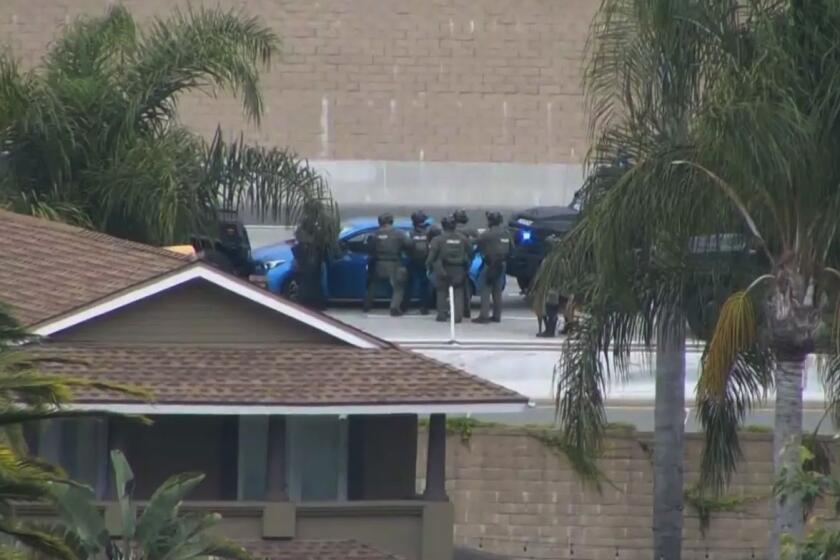Opponents Brace for Hearing on Plan for Toxic-Waste Burner
Less than two weeks away from a public hearing on a proposed hazardous-waste incinerator in Vernon, Bell city officials and environmentalists say they have begun to gear up to fight the project.
The incinerator would become the state’s first commercial hazardous-waste incinerator in an urban area. It has been proposed by California Thermal Treatment Services, a wholly owned subsidiary of Security Environmental Systems in Garden Grove.
Critics argue that other incinerators have been plagued by problems and that the new technology involved calls for a full environmental impact report--a lengthy and expensive process that has not been required by any of the state or federal agencies involved in the permitting process.
On Wednesday, led by Bell City Councilman George Cole, about 60 residents and opponents gathered in the Bell Community Center to voice concerns over the concept and the permitting process. The $29-million facility would be built on 9.9 acres at 3691 Bandini Blvd.--less than two miles from Bell.
Want Environmental Report
“They still haven’t done an environmental impact report, which to me is unconscionable,” Cole said. “If the City of Irwindale (is required) to do an EIR to build a football stadium in a gravel pit, then they can do an EIR here.”
Cole said the opponents have just begun to fight the incinerator.
“We wanted people to be aware that this is going on, because there has been very little publicity about this whole process,” Cole said. “The (forum) is a first step.”
Wednesday’s meeting came in anticipation of a Dec. 1 public hearing in Commerce that is one of the final steps before a decision is made on whether to grant a building permit for the incinerator. The company has received a permit to build from the South Coast Air Quality Management District, site approval from the EPA, and declarations from the City of Vernon and the Department of Health Services saying an EIR is unnecessary.
After the December public hearing sponsored by the Department of Health Services and the EPA, California Thermal will lack only permits to construct, under the Resource Conservation and Recovery Act, from those two agencies.
Estimate of Time
According to Donald Bright of Bright and Associates, the consulting firm handling the applications and tests for California Thermal, it would take 16 months from the time the final permit is granted to the time the facility could begin trial burns.
When fully operational, the system is designed to burn 22,400 tons of hazardous waste at 1,800 degrees Fahrenheit. It would burn 24 hours a day, stopping only for maintenance.
Bright said the facility will not accept any PCB-contaminated waste, waste containing more than 10 parts dioxins and furans per million, or waste that is radioactive, explosive or infectious. The facility will burn only 10 types of hazardous waste, including hydrocarbon solvents such as the highly toxic benzene, halogenated and oxygenated solvents, mixed oil and separation, degreasing and paint sludge.
About 29% of the possible annual supply is generated within five miles of the plant, much from factories in the heavily industrialized Vernon area, which the State Department of Health estimates produces more than 2,800 tons of hazardous waste annually.
Would Dump Ash
The incinerator would reduce the hazardous waste by 98% of volume. The remaining ash containing toxic heavy metals would be dumped in hazardous-waste landfills.
A number of proposed incinerator projects have met stiff public opposition. Those include Los Angeles’ now-dead Lancer project for municipal garbage, Stauffer Chemical Co.’s stalled hazardous-waste incinerator in Carson, and Pacific Waste Management’s solid-waste incinerator plant for municipal garbage in Irwindale. Long Beach is building a waste-to-energy incinerator for municipal garbage on Terminal Island, a project that drew little opposition.
With the phasing out of landfills for hazardous-waste disposal, incineration is touted by Bright and others as the solution of the future.
But opponents at the Wednesday meeting stressed that reduction of hazardous wastes should be emphasized, not incineration. Cole said that the past EPA budget was $1.5 billion, but less than $400,000 of that was spent on recycling and reduction of hazardous waste.
Among those opposing the Vernon incinerator at last week’s meeting were representatives from Greenpeace, Citizens for a Better Environment, Concerned Citizens of South Central Los Angeles (which helped defeat the Lancer municipal waste incinerator) and the Cal Alliance in Defense of Residential Environments. Spokesmen from the offices of Sen. Art Torres (D-Los Angeles), Sen. Bill Greene (D-Los Angeles) and state Assemblywoman Lucille Roybal-Allard (D-Los Angeles) also opposed it.
Watched Opposition
Bright watched the opposition from the last row of the auditorium but declined to formally address the audience. “In these sorts of things, they have their minds made up. They come here to excite each other and to discuss the same old issues,” Bright said. “We have addressed every single one of the issues discussed tonight in our newsletters.”
California Thermal’s health-risk assessment has maintained that its $9-million, state-of-the-art air pollution control system will permit an acceptable level of harmful emissions to escape from the plant and that the constant high temperature in the incinerator’s kiln and afterburner will avoid the creation of “intermediate products” such as dioxins and furans, as has been the case at other incinerators. Some dioxins and furans have been known to cause cancer and birth defects in laboratory animals.
California Thermal has had to demonstrate a destruction and removal efficiency of 99.99% and show that the individual risk from the facility would be less than one excess cancer case per million people.
‘Never Proven’
But Bradley Angel of Greenpeace said it has “never been proven that a toxic incinerator can perform at (optimum) levels at all times.”
“Every toxic incinerator emits a small amount of the chemicals fed into it,” Angel said. “When you’re burning large amounts of waste, that adds up.”
Cole and Angel also argued that the health risk assessment had not taken into account that Vernon has 43 meat processors, packers, distributors and wholesalers, including Farmer John and Oscar Mayer plants. Those plants, they argued, could be contaminated by emissions if the facility ever malfunctioned.
Opponents also said a permit for the plant should not be issued while Los Angeles is in violation of the federal Clean Air Act.
Bell has voiced its dissatisfaction over the lack of an environmental impact report in the past, sending letters to the AQMD in March, 1986, and to the City of Vernon in April. Bell city officials rejected an Omega Chemical Co. proposal for a similar plant in August, 1986, after reviewing an environmental study.
More to Read
Start your day right
Sign up for Essential California for news, features and recommendations from the L.A. Times and beyond in your inbox six days a week.
You may occasionally receive promotional content from the Los Angeles Times.






